
Yes, yes, I know: I have not been in the habit of giving subtitles to the prize posts in the Author! Author! Great First Pages Made Even Better Contest, but frankly, I felt that my feedback on today’s winning entry, GOTHIC WARS by Carolin Walz, warranted it. Turbulence fought penmanship, and I fear that for the most part, turbulence won. Since this has historically been the fate of many a manuscript whose marginalia was penned on the way to or from a writers’ conference — oh, you can think of a better use of flying time than reading submissions? — I felt that it was only fair to present all of you with the results, so you may recognize travel-skewed comments when the agent of your dreams presents them to you.
With the advent of electronic submissions — still not universally accepted, but climbing steadily in popularity — you’d be astonished at how many agents reading submissions on airplanes around this time of year. Specifically, on their electronic readers.
Surprised? Or even alarmed at the prospect of your meticulously-formatted pages being read on that small a screen? Well, think about it in practical terms: if you were an agent traveling over the river and through the woods to Grandmother’s house, which would be more efficient to tote as reading material, a couple of heavy manuscripts — or 30 electronic submissions on your Kindle?
Of course, this is only likely to be the case at agencies that accept electronic submissions. And even then, typically, those Grandmother’s house-bound submissions (or, at this point in the weekend, those returning from Grandmother’s) will have had to make it past Millicent the agency screener’s strict scrutiny before making it onto the boss’ Kindle.
Which just goes to show you: electronic submissions can be pretty well traveled. Yet all too often, aspiring writers assume, wrongly, that the simple fact that they’ve sent their manuscripts as Word attachments to an e-mail automatically means that everyone who might conceivably read their submission will have access to their contact information.
“After all,” these submitters reason, “all Millicent or her boss has to do to say yes to me is to hit the REPLY key. What could be easier than that?”
What, indeed? Unless, of course, your electronic submission has been downloaded to an electronic reader. Then, it actually isn’t inconceivable that an agent could fall in love with a manuscript — and yet have no idea how to get in touch with the person who wrote it. Or even be sure who did write it.
Scary prospect, is it not? Breathing into a paper bag should reverse that hyperventilation within a couple of minutes.
“But Anne,” some of you wheeze, “couldn’t the agent just ask his Millicent to comb through the agency’s e-mail inbox? Surely, my original e-mail would be in there, right?”
Possibly, but do you have any idea how many e-mails an agency that accepts electronic submissions receives in any given week? Or even on any given day? Forget about finding a needle in a haystack — Millicent would be looking for a needle in a hay field.
Fortunately, this dire extremity is easy to avoid with a little advance preparation on the submitter’s end. First, it’s always a good idea to include one’s full contact information with any submission, electronic or otherwise; don’t you want the agent of your dreams to be able to call you with any follow-up questions she might have? Second, it’s an even better idea to include precisely the same title page a savvy submitter sends along with a paper submission in an electronic submission.
How is that possible? It’s not particularly difficult in a Word file: just copy and paste your title page at the top of your manuscript document as its first page. To avoid the title ending up with the slug line that every other page in the manuscript should feature in its top margin, select DOCUMENT from the FORMAT menu in Word, then choose LAYOUT. Click “Different first page.” Then you can just clear the header for the title page, while leaving the rest of the document as is.
Ah, I hear some of you murmuring, but doesn’t that mean that the first page of Chapter 1 would be numbered as page 2 in the slug line? (For those of you who are not in fact murmuring that, but instead are wondering what the heck a slug line is, it’s the AUTHOR’S LAST NAME/TITLE/PAGE # that appears in the upper-left corner of a professionally-formatted manuscript. For some visual examples and explanation of how to include this important information correctly on your pages, take a gander at the SLUG LINES ILLUSTRATED category on the archive list at right.)
There’s a way around that, too: under the INSERT menu, choose PAGE NUMBERS…, then FORMAT. Under PAGE NUMBERING, simply set the “Start at…” number to 0. Voilà! The second page of the document is now page 1!
“Aha!” those of you still breathing crossly into your paper bags gasp. “I’ve got you now, Anne. Why wouldn’t the agent of my dreams simply look at the top of any page of my manuscript to see what my name was? If Millicent misplaced my original e-mail, she could just do a search of her inbox under my last name. Problem solved!”
Quite true, oh gaspers — provided that you included a slug line. You would be positively amazed at how many electronic submitters (or, heck, paper submitters) do not.
How much difference could the omission possibly make to a submission that did not go astray, you ask? Well, since the fine folks who read manuscripts for a living expect every page of every manuscript to include a slug line, quite a bit.
See for yourself. Here is today’s winning entry in the format that the judges first encountered it:
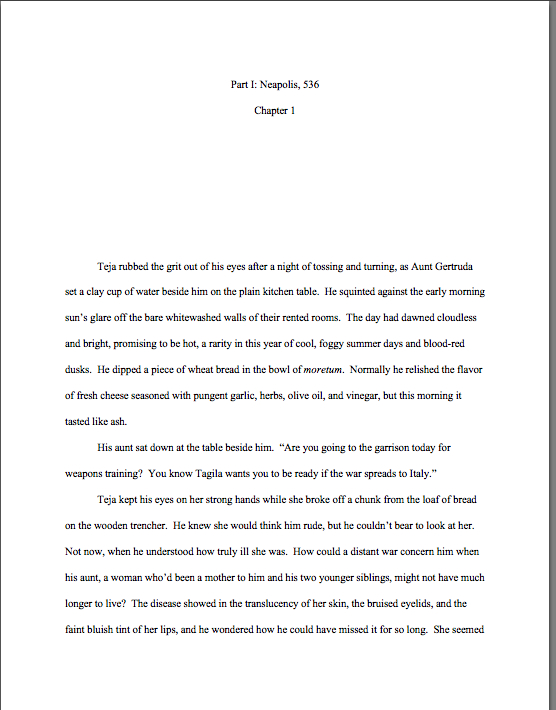
A bit bare on the top end, isn’t it? Here it is again, properly formatted:
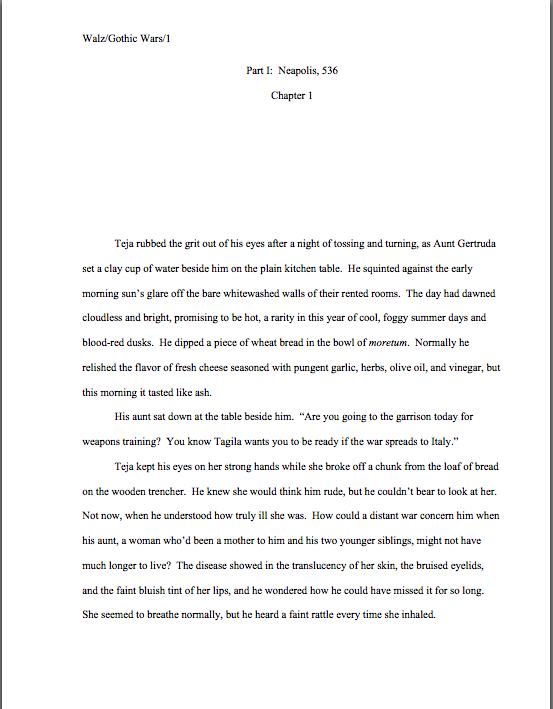
Makes more of a difference than you would have expected, doesn’t it? As does another small formatting change: two spaces after the colon in the Part I designation, rather than the original one. Again, it’s a seemingly small thing, but to eyes sharpened to the norms of professional manuscripts, it would jump out.
Some of you former wheezers have your hands in the air now, I see. “But Anne, didn’t you do something else to the formatting? There are more words in the second version, are there not? The last sentence on each page is different.”
Well spotted, ex-hyperventilators. The difference between the first page and the second is that the first is in TextEdit, the second Word.
About 10% of the entries in this contest arrived in TextEdit, although the rules had specified sending the first page as a Word attachment to an e-mail. The judges decided not to disqualify entrants for this, primarily because it would afford me such an excellent opportunity to talk about why this would not be a good way to submit electronically to an agency or publishing house.
Word is, quite simply, the U.S. industry standard — when an agency asks submitters to send pages as attachments to e-mails, they mean a Word attachment. Specifically, a .doc document, not a .docx document, since many agencies are running older versions of Word. (If they are running a really old version of Word, you may have to send your pages as a .rtf document, so they will be able to open it.)
You should honor this expectation; send any requested materials in Word, not TextEdit or any other word processing program you happen to favor. The fact that it is possible for a Word user to do as I did, convert a TextEdit document into Word, does not mean that Millicent will necessarily be willing to do it; after all, her boss would not be able to submit your book electronically to an editor at a publishing house that way. A U.S.-based agent would certainly expect any writer it signed to convert all manuscript documents to Word, anyway, so in the long run, it will actually save time to just write your documents in Word in the first place. (If you are unsure how to format a manuscript page in Word, please see the obscurely-titled HOW TO FORMAT A MANUSCRIPT category on the archive list at right. Or just stick around here at Author! Author! for December, when I shall be going over the rigors of standard format again. So dig out your long-harbored formatting questions, people!)
Besides, as we saw above, the formatting is not always identical. In a submission where length is an issue — if, say, the manuscript goes over 400 pages, Millicent’s usual oh, dear, that’s a bit on the long side limit in most fiction categories — even those few extra words per page may make an overall difference. Sometimes, standard format is the writer’s best friend.
Don’t believe me? Okay, let me ask you: how much time have we spent so far talking about technical and presentation issues in Carolin’s fine first page, and how much about either the writing or the content? THAT’s how distracting these issues are to professional readers.
It’s genuinely a pity here, because Carolin has a terrific book concept. Here’s the way she described it to the judges:
The historical novel Gothic Wars tells the story of Emperor Justinian’s reconquest of Gothic Italy in the sixth century CE from the point of view of the last Goth king, Teja. It provides a fresh look at a war that is usually seen through the victors’ eyes (like Robert Graves’ Count Belisarius).
Interesting, eh? Here’s her 1-page book description.
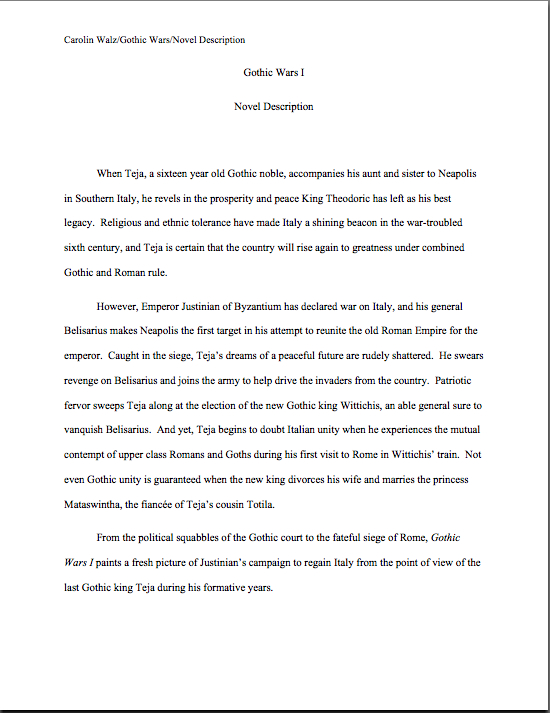
Again, fascinating — but once again, we’re distracted by formatting, aren’t we? The slug line contains a first name, sixteen-year-old is not hyphenated (a mistake that I have been seeing more and more over the last couple of years; is this rule not being taught anymore?), and there is odd, additional spacing between the lines. Here’s that page again, with just simple double-spacing:
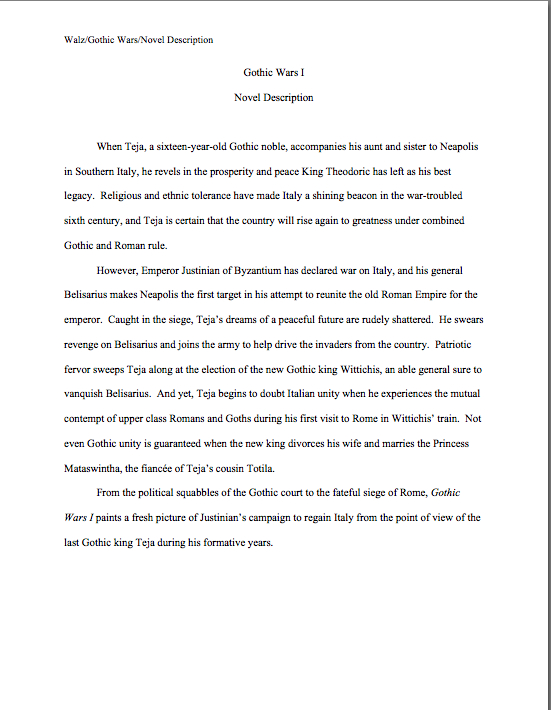
Once again, we see what a big difference seemingly small formatting issues can make. Actually, tinkered-with spacing between paragraphs is fairly common in submissions. It puzzles the pros: since just selecting double-spacing under the FORMAT menu (it’s one of the choices under PARAGRAPH) is actually far easier for the writer than manually changing the spacing between the lines, why does anyone go to the extra trouble? It’s not necessary; Word will do it for you.
And once again, we’ve been distracted from the engaging story and the writing by technical issues. Let’s see what Millicent would have to say about something other than presentation, shall we?
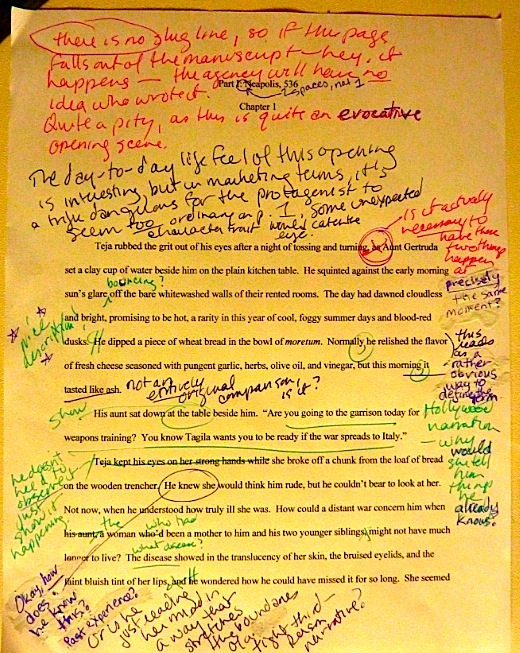
Hey, I wasn’t kidding about that turbulence. (Don’t worry; the copy I shall send Carolin will be legible.) But as you may see, Millicent’s first instinct was to point out the formatting issues. She also raises an interesting point that affects the marketability of many realistic novels.
Carolin has done a beautiful job here of giving the gritty feel of Teja and Gertruda’s quotidian life, hasn’t she? And she does it primarily through showing, not telling: the level of practical detail here is excellent. It’s also quite clear — and this is rarer in historical fiction submissions than any of us might like to hear — that she’s done her homework: as a reader, I believe that these specifics are historically accurate.
That’s all going to be great for readers after GOTHIC WARS is published, of course, but it could present a problem at the submission stage. Teja comes across here as an ordinary person, not an extraordinary one. From the synopsis, of course, we know that’s not the case in his life overall. However, as we have seen throughout our discussions of all of our Great First Page Made Even Better winning entries, Millicent tends to make up her mind about whether she wants to follow a protagonist onto page 2 based exclusively on page 1, not the synopsis or brief description in the query letter, a too-ordinary-seeming protagonist may not provide the temptation to read on she wants.
Fortunately, this is a very easy fix: Teja merely has to exhibit some extraordinary quality on page 1. If Carolin likes the dramatic arc of having a young boy develop extraordinary qualities over time — as most historical novelists tend to prefer — she can always resort to the tactic I suggested for yesterday’s winning post: open with a prologue set later in the book, then revert to this scene after.
In historical novels, this strategy often works beautifully. I would be especially pleased to see Carolin try it here, because it’s fairly likely that Millicent will not know much about the wars in question. A well-crafted, informative prologue could go a long way toward convincing her that readers will consider this historical event inherently interesting and important.
Hey, it’s not always a foregone conclusion. And Millicent is far more likely to have been an English major than an ancient history concentrator, if you catch my drift.
Did you catch the nit-pick in the first line, or did turbulence prevent your being able to read the handwriting? Any guesses why Millicent might ask is it actually necessary to have these two things happen at precisely the same moment?
If you immediately shouted, “By Jove, it’s in response to the use of as in that sentence,” take a gold star out of petty cash. X happened as Y happened is an immensely popular sentence structure in novel submissions; one sees it less in published fiction. And that’s a bit surprising to many aspiring writers, because, let’s face it, quite a few things do happen simultaneously in the real world.
Why the differential? Because editors have been scrawling in the margins for decades is it actually necessary to have these two things happen at precisely the same moment?
Most of the time, it isn’t. Nor is it here: it doesn’t actually add either plot or character development to Carolin’s page 1 that Teja’s rubbing his eyes as Aunt Gertruda gives him the water. If the actions came one after the other, or even if they were reversed, it would not affect the reader’s understanding of what’s going on here, right?
The simultaneity implied by as is often not necessary to the reader’s understanding of what is going on; it’s simply the writer’s attempt to be factually accurate about a series of events. But by using this structure when the simultaneous nature of two different happenings is not relevant to the scene, a narrative can both (a) mislead the reader about what actually is important for the reader to notice in the scene and (b) over time, cause the reader to tune out as as an indicator of timing.
That last one is problematic, potentially, in a story with a lot of action in it. At some point in the story, it’s going to be vital that the reader understand that X happened as Y happened. So it’s an excellent idea to reserve as, like profanity, for only those moments when it will have the most effect.
Let’s see, what else did our Millie flag? How about the Hollywood narration in the second paragraph?
We’re all familiar with Hollywood narration, right? It’s a staple of television and movies: one character tells another something they already both know, simply so that the audience may learn it, too. As in:
Joyce: Oh, Kent, my husband of twelve years, how glad I am to see you safely home! You know how your job as a test pilot of experimental aircraft frightens me.
Kent (chuckling ruefully): Honey, you have been worrying about me since that long-ago day in college when you first saw me slip on the ice-covered library steps and slide head-first onto the quad. You should know by now that my head’s as hard as a rock!
Joyce: Well, you’re not the one who is going to have to explain your sudden, fiery demise to our three children — Lara, eight; Timothy, twelve, and little Ghislaine, six — are you?
Kent: I suppose not. Nor would I have to face your father, the senator from our fair state, should you become widowed. As you yourself heard me tell not only him, but a crowd of two hundred of our nearest and dearest at our fifth anniversary party — which, as you may in fact recall, was held at Chez Georges, the fanciest French restaurant in town — your well-being and happiness is my highest priority.
Joyce: Except, of course, for our children’s. Why, just six months ago, when Lara rode her bike into the side of that truck and you had to rush her to see old Doc Courtland — he who delivered both all of our children and myself — you were magnificent.
Kent: So, too, were you that time that our youngest, not yet out of diapers, went wandering off into that cornfield and got kidnapped by aliens. I was so impressed when you…
Well, I won’t bore you with what happened after Joyce followed Ghislaine into that field; suffice it to say that the next ten minutes of dialogue concern her many lacerations and burn scars. But why should Joyce and Kent be reminding each other of these major life events at all, when it’s completely beyond the realm of possibility that either party should have forgotten about any of them?
Evidently, just so you, dear readers, will know about them, too. Trust me, Millicent will not find this presentation subtle.
Which is a shame in this case, where the Hollywood narration is rather subtle: Gertruda might actually have asked this question. However, since this information would also have been perfectly easy to introduce in a couple of narrative sentences — unlike TV and movies, novels do not rely exclusively upon dialogue and visual cues to convey information to their audiences — it’s probably best to err on the side of giving even the implication of Hollywood narration a wide berth.
Especially if, as here, it comes with a signpost. Generally speaking, any time a character says, “You know…” there’s an excellent chance that what she is about to say next is Hollywood narration, and thus could be cut.
We wouldn’t want to distract Millicent from that nice description in the first paragraph, would we? Or from those evocative details in the last one?
So nicely done, Carolin — you’re a set of quite minor revisions away from a genuinely stellar first page. Which is, I hope, precisely why members of the Author! Author! community will find this and our other winning entries both helpful and inspiring: the difference between a manuscript that wows Millicent and one she rejects is often based upon not her overall perception of a manuscript’s writing quality or marketability, but the cumulative effect of a series of small, rather subtle problems that could, with patient revision, be polished away.
Keep plugging ahead, Carolin — and everybody, keep up the good work!
Conveniently I’ve always worked in Word. Yet I often hear fellow writers wondering about special templates and programs for preparing manuscripts. I’ve found it only takes a matter of seconds to open a new document, set the margins and line spacing, and begin the writing process.
Back when I was struggling to learn what standard format was, I did discover that one can set one’s computer up to give a different spacing when hitting the return button than when reaching the end of a line and the computer automatically moves down the set number of spaces. In other words, double spaced within the paragraph, but triple spaced (for example) between paragraphs. As you indicate, totally unnecessary.
Dave
I hear that a lot, too, Dave. I’m constantly meeting writers who have gone to a tremendous amount of trouble to set up a template or track down a macro; I always feel a bit guilty telling them that they needn’t have put in the additional time.
So Dave is quite right, everybody: once you’re used to the strictures, it actually does take only a matter of seconds. And if you set the norms of standard format as the default in Word (oh, how I wish there were just a box to check for it!), it will happen automatically.
Anne, thank you for this lovely analysis. I’m hanging my head in shame over all of the formatting gaffes. I do know how to save in Word and actually work in it, but my writers’ group only works with .rtf files, so I can only assume that I didn’t convert back to Word before hitting the ‘send’ button….
Some questions (and I know I’ll have more), but as I just returned from Germany a couple of days ago, I’m still a bit jet-lagged – your blog title made me grin…. So here are the first ones that may have some relevance for other writers, too, especially those who write historical fiction.
It may help to know that I’m (an anal) German, i.e. I love details, tend to write long (and love to read long novels), and have some trouble with the American way of fiction writing, i.e. action- and dialogue-driven and dominated by short paragraphs.
You say you like the detail and think it’s historically accurate (it is – I did PLENTY of research *grin*). However, folks in my writers’ group and others (like fellow profs in our writing program) tell me that this level of detail is no longer desirable, as modern readers’ short attention spans need shorter, punchier scenes without so much immersion into the minutiae of the world the action takes place in. (You can see I’m German – love convoluted syntax….) So, my question is, do I have to ‘dumb down’ the story to suit the American market? I found myself doing that in some later chapters and really don’t like it.
That ties into my second question about the Hollywood narration (ouch! read your blog entries about that in Germany and didn’t even notice that I was guilty of it, too). In another version of this page, I don’t even have any dialogue and don’t yet mention the war so directly. However, based on your blog and my WG’s comments, I decided to change that based on the comment that long narrative paragraphs a la Dickens on a first page are no longer de rigeur and would get your first page tossed by Millicent very quickly. Also, the ‘central conflict’ needs to be clear right on page one – so I made it clearer than I had it at first, killing two birds with one stone, I thought. Now you say that a few more narrative sentences would have been fine, esp. in a historical novel (I’d love that!) because Teja knows about the war already, even though the reader doesn’t and crude sign-posting leads to Hollywood narration. So can I do without dialogue on page one in favor of more narration?
Last question for now: the issue of a prologue. You’ll laugh, maybe, but I have one planned, had it planned from the outset. But I haven’t written it yet since I’m not quite sure what I want to do there. Here’s the question: you want to entice Millicent (and other readers) to read on based on the prologue. How do you deal with it if you have a project that you know will entail more than one book (say, a trilogy)? I thought at first to use material right from the end of the tale, i.e. from the LAST volume, as it’s incredibly dramatic and closes the circle back to Neapolis. However, I don’t want to give too much away right at the beginning (fortunately, most people don’t know much about this piece of history, so I can keep the tension ratcheted up – don’t want to give away the surprising plot twists right at the outset). As a writer, should one take the prologue material from the CURRENT volume? Or can one take material from later parts of the story that aren’t covered in that book?
Sorry for this long-winded post, but your comments generated a lot of thought 🙂
Carolin
My pleasure, Carolin! And I love detailed questions.
My answer on the dumbing-down issue is a most emphatic no — and frankly, I’d be quite surprised if anyone familiar with the historical fiction market of the last couple of years could point to a successful first or second novel in that book category that did deliberately eschew historical detail. You go right on researching; assuming an intelligent readership interested in history is completely justified in historical fiction. As long as you don’t abandon story for explanation for pages at a time, or summarize events instead of showing them as scenes (which may be what detail-critics are talking about), you should be fine.
While it is true that if you look at the overall fiction market since the economic decline, more novels with quicker scenes have been selling, but that’s largely a function of the incredible burgeoning of YA — which has pretty much always leaned toward shorter, faster-paced scenes than adult fiction. But unless you were deliberately aiming this book for the YA market (which doesn’t seem appropriate for this story), I don’t think that should affect your narrative style. And speaking as a writer, heaven forfend you should embrace a voice you actively dislike.
But then, I’m always a bit wary about pronouncements like nobody wants to read detail anymore, or indeed, assessments of a changed market that profess to cover all fiction. Norms vary by category; so do trends. One does hear rumors and opinions about how electronic media will affect writing styles, but at this point, it’s still mostly speculative.
I don’t think you need to eschew dialogue in favor of explanation on this page, though. Why not have Teja worrying about the imminent conflict? Or Gertruda working on some aspect of his battle array, bemoaning that she doesn’t have the extra month to finish it that she would like? Either would provide a perfectly legitimate excuse for them to talk about the larger conflict without either cutting the interaction between the two characters (which I like as character development) or falling into Hollywood narration.
I’ve sure been getting a lot of questions about book series lately! Generally speaking, it’s more satisfying for the reader if the prologue material recurs within the same book, but there’s another, more practical reason not to project farther into the future: if the first book doesn’t sell to a publisher (or, in some book categories, sell well to readers), the second and third book are moot, right? Your job at this juncture is to make Millicent fall in love with the first book, not the series. So at the submission stage for the first book, you should really be concentrating on just that, the first book.
After you have landed an agent, though, you should definitely discuss the series issue. If the agent believes s/he can sell the entire trilogy at one fell swoop (it does happen, but rarely in your chosen book category), s/he may well want you to use the material from the end. (It would also add a nice Ring cycle touch to have the ending wrap around to the beginning.) Remember, the manuscript is probably going to undergo changes both after you sign with an agent and after you sign with a publisher. The decisions you make now are not set in stone.
Does that feel liberating, or terrifying? Personally, I really enjoy knowing that I can continue to tinker, but that’s not to every writer’s taste.
I’m with you on the “as”, Anne. Ray Rhamey wrote a blog posting about a related topic: misusing “as” when the actions aren’t truly simultaneous: http://www.floggingthequill.com/flogging_the_quill/2006/08/watch_your_as.html
I’ve also seen a lot of participial phrases used to create unnecessary or incorrect simultaneity. Between “as” and “-ing”, I’ve seen up to four simultaneous activities in one sentence. My weak mind couldn’t keep track of them all. 🙂
I suspect that we writers lean on the simultaneity in order to avoid producing either a bunch of choppy sentences or and…and…and (https://www.annemini.com/?p=10574). Maybe we should consider this advice instead: “just because something happens in the real world doesn’t necessarily mean that a transcript of it will make compelling reading”.(https://www.annemini.com/?p=10647)
Writing that play-by-play transcript is just so habitual, though. Maybe it’s from watching TV and movies, I dunno. ‘Tis lamentable that our readers aren’t as comforted by the transcript as we are.
I’m with you about the effects of TV and movies on manuscripts, Doug. You wouldn’t believe how many otherwise well-written submissions use only the senses of sight and sound to tell their stories, as if the novel were as limited as film in creating impressions.
It’s also my considered opinion that many, if not most, writers don’t really think in the moment of composition about whether they are reusing sentence structures. A reader might notice that as constructions turn up several times on a single page, but the writer tends to concentrate on a single paragraph at a time, or even a single sentence. Thus, the cumulative effect of a tendency toward simultaneity might be lost on a writer who does not reread large chunks of his work at one sitting.
I’ve been using a program called PageFour to write my first drafts. One of my coworkers told me about it. It has notebooks and pages, and I write each scene in a page, then I can smush them together into chapters and into a whole manuscript. Then I can export into Word. THEN I can begin editing, revising, etc.
I like it because there’s no distracting reformatting as I type. Also, I don’t have to scroll way down in a huge document to find something I need to refer to when I’m in the planning/first execution stage.
What do you do later in the process, Elizabeth? Convert to Word? And if so, is it an easy conversion?
Anne, I do the structuring before I export –merging it into chapters– and it slides right in. The rest of my formatting/editing/revising then takes place in Word. I only do that AFTER the first draft is finished, however.
I did find I had to cut stuff later from Rose’s Hostage but I just deleted a couple of chapters and then renumbered them in the Word document. It wasn’t too bad. Now that I’ve done it once, it will only get easier. 🙂
Oh, that’s good to know.
Anne has already covered this, but I think any detail that moves the story forward is a keeper; any that adds insight into character is good, and any that adds texture or depth to the world is good but might be unnecessary. Orson Scott Card had a great analysis of what genres call for what kind of detail and structure that he called the MICE quotient. It’s in one of his Writers Digest series books, I forget which, but very, very helpful when approaching all the info you want to convey to the reader.
And I totally agree that writing only gets better with rewriting. I write such ridiculous sentence structure when I’m in the rush of creating some new chapter or subplot that you would never, ever know I copy edit for a living. Usually by the fourth or fifth draft I’m catching most of it.
“I catch” most of it.
I’m with you, David — as long as the detail-dropping doesn’t go on so long that it feels as though the scene has stopped cold. It can be a fine line between fascinating and distracting, can’t it?